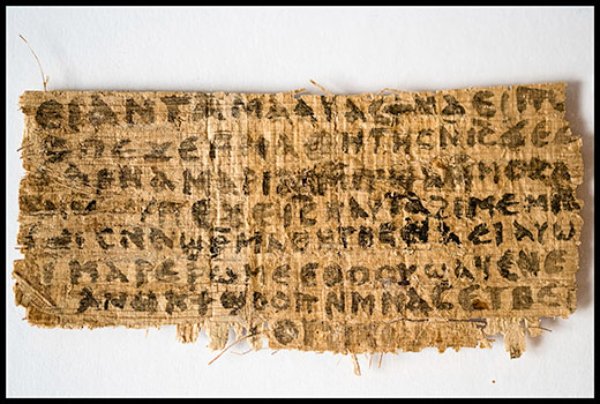In September 2012, Karen L. King, the first woman to hold Harvard University’s 295-year-old Hollis Professorship of Divinity, announced at a meeting in Rome the discovery of a piece of ancient credit card sized parchment that contained scraps of dialogue written in the Egyptian language of Coptic supposedly of a dialogue between Jesus and is disciples where Jesus refers to “my wife”.
The suggestion that Jesus was married, likely to Mary Magdalene, naturally caused a sensation within the global Christian community and with scholars of ancient texts. The Vatican naturally denounced it because the idea that Jesus was celibate and entrusted his mission only to male disciples forms the basis of its policy of only allowing celibate male priests and treating women as second class. Reporter Ariel Sabar was assigned by Smithsonian magazine to cover the story and published this article about it.
There were suspicions, based on flaws in the wording of the script, that the parchment was a fake even though tests showed the papyrus was ancient and the ink used corresponded to those used in those days. Despite the skepticism of some of her colleagues, King remained convinced that it was genuine.
As Sabar watched the subsequent debate unfold about whether or not the parchment was genuine, he became interested in a question that was not being closely looked at, and that was the provenance of the parchment. In the world or art and antiquity, the provenance of a piece of work is its history of ownership and can shed light on legitimacy.
So he started investigating the ownership chain and has written about what he found in a long but fascinating piece that reads like a detective story. He uncovered the trail of an elusive and wily operator named Walter Fritz who cunningly was able to persuade King to convince herself that she had been given a historic document.
King, after reading Sabar’s article, says that the evidence now points to the parchment being a fake. One feels sorry for her but the story is a cautionary one about how even noted scholars can let their guard down and be fooled when dealing with evidence that is congenial to their point of view.


The proto-orthodox Christian hatred for sex and enjoyment runds deep and long. Jesus the man, in the canonical books, never evidences any interest in women or family life (or a job for that matter) and yet is supposed to be fully human. Anything originally human (if anything) was scrubbed from day one.
As for another controversial gospel, that of Mary Magdeline, where Jesus kisses Mary, I like to think the missing word is veranda -- its just so romantic.
How should this story make us feel about Professor King?
On the one hand, she succumbed to an irrational bias which can be seen as her failing to properly execute her role as an impartial academic. Of course we are all guilty of similar ‘offences’ from time to time, yet one would hope her training and professionalism would provide her with better defences than most. For a public intellectual this is, at minimum, some degree of let down.
On the other hand she now acknowledges the mistake, and in doing so has overcome a perhaps more difficult bias -- once a decision is made we require much greater evidence before we are willing to admit we were wrong and change our mind. She championed this idea for four years and, as high profile as it was, it must have been an important element of her career. Climbing down from that position, even when presented with strong counter-evidence, is no easy thing and requires intellectual honesty.
So what do people think? Overall has Prof. King’s reputation been enhanced or taken a hit?
Milton,
I think that on balance her reputation has been hurt. Part of the problem is not so much being hoaxed but that while Sabar was working on the story, he offered to discuss what he had found on the provenance issue with her and she showed little interest.
That looks bad to me, as if she were hoping that it would all go away.
History is replete with scientific hoaxes, such as Piltdown Man, The Turk chess-playing robot, and the archaeoraptor fossil.
Usually the hoax “confirms” what the scientist has already decided to be true, so the scientists’ egos are inflated, making it even easier to trick them, and making them reluctant to even entertain the thought that they might be wrong.
We are often our own worst enemies.
“I haven’t engaged the provenance questions at all,”
This shows an astonishing level of incompetence or, perhaps more charitably,gullibility.
As moarscienceplz says Pildown Man, and I’d mention the Hitler Diaries, or closer to her field the James Ossuary, or perhaps the Donation of Constantine.
I would have thought that a scholar, who should have been aware of earlier frauds, would like to know the provenance and see if that suggested a reason that it was in Coptic. If it was more or less contemporary with I’d have expected Greek—would not need to be but it would be one more red flag if there was no explanation.
I don’t think it was ever believed to be contemporary to Jesus. If real, it was supposed to have been from around the year 300 or 400. Too late to say anything about the historical Jesus, but still interesting to know what Christian communities at the time believed. So Coptic would be in line with that expectation.
“aturally caused a sensation”
And that was totally silly. Even if the text were genuine it would have proven nothing; it only would have proven what some Kopts in Egypt believed quite a while after Jesus actually lived.
Anyhow Dutch scholar Jona Lendering immediately strongly doubted if the text were genuine exactly because its provenance was lacking. In addition another Dutch scholar, Richard Kroes, explained how easy it is to forge old texts.